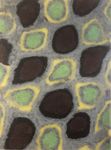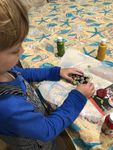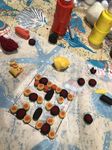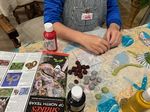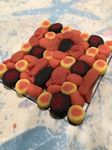Lesson Plan: Snakes on the Plains - Wichita Falls Alliance for ...
←
→
Page content transcription
If your browser does not render page correctly, please read the page content below
Lesson Plan: Snakes on the Plains
Tactile Exploration of Patterns and Colors of North Texas Snakes
Meets the learning standards for grades 4-5 (can be adapted)
Media Type: Salt Clay
Subject Integration: Fine Arts, Science, English Language Arts and Reading
Description of the Activities/Workshop: Exploring the properties, colors, and markings of native
North Texas snakes; Using multicolor clay to design a unique snake scale pattern inspired
by a specific species.
Why am I teaching this: Arts Integration Thread (to catalyze the learning of content outside of
art), Art Skills Development Thread (to deepen the development of art-making skills)
Materials: wax paper or parchment paper, rolling pin (or any cylindrical object. We used
unopened drink cans), slicing tool (many options here, such as a small paring knife, a metal
spatula, or even a strong piece of string or wire), Victorian Salt Clay (see easy,
microwavable recipe here https://wichitafallsarts.org/a-plus-projects/lesson-plans-k-
5/microwavable-and-flourless-homemade-clay/), food coloring or acrylic paint, straight
edge (optional)
TEKS: 110.7 knowledge and skills 1, 3, 5, 6
112.15 knowledge and skills 4, 9, 10
112.16 knowledge and skills 3, 9, 10
117.14/117.17 knowledge and skills 1, 2, 4Focus Question: How can the patterns and colors of snakes serve as inspiration in art-making?
Opening:
1. Share this Creature Feature video from our friends at the River Bend Nature Center, in
Wichita Falls!
https://youtu.be/o8fZA8pu_CE?list=PL2hUi8CWJXbJPoWgtxqlmCbj_YqZRjdoX
Activity 1:
2. Has anyone ever seen a Bull Snake, like the one in the video? What other snakes can
learners name that are native to the area?
3. Share this resource of North Texas snake species. Allow learners to discuss their
observations, specifically about coloration and markings.
http://www.texassnakeid.com/Most_common.html
4. Encourage learners to select a specific native snake to research further. How do they
move? What do they eat? Where do they live?
5. Ask learners what they know about scales. What are scales for? Share this resource with
more information https://www.floridamuseum.ufl.edu/herpetology/fl-snakes/color-
pattern/
Activity 2:
6. Learners will use colored clay to create their own snakeskin inspired designs. Instruct
learners to identify 3-4 colors that they will need to use in their designs.
7. Spread out wax paper to use as the work surface and instruct learners to divide the
microwavable Victorian Salt Clay (https://wichitafallsarts.org/a-plus-projects/lesson-
plans-k-5/microwavable-and-flourless-homemade-clay/) into smaller portions, and dye
it the desired color by adding food coloring or acrylic paint. The paint makes a big mess,
but once it is fully mixed in it stops being messy.8. Learners will consider the pattern they are attempting to create and begin forming small balls to arrange in their design. 9. The different balls of clay should all be similar height, and need to be arranged closely, but do not have to be an exact fit.
10. Once learners have completed their design, they should lay a piece of wax paper over
the design and gently press the paper down to secure it.
11. Now it’s time to use the rolling pin or cylindrical object to roll out the design. Learners
should experiment with rolling direction and pressure until they have rolled it out to
approximately 1/8-inch, uniform thickness.12. TAH-DAH!! Learners should remove the top layer of wax paper and admire their work.
How was their design distorted by the rolling process? How does this art project reflect
what we observed about the designs on snakes?
13. Allow the project to air-dry on a flat surface. What other patterns and designs could
learners make using this technique? Here is a video demonstrating how to make multi-
colored rings for more complex patterns: https://youtu.be/qTxdWOESB5Y
Closing:
Share… Reflect! Invite learners to share what they learned in this process and to talk about
their work. For learners who are interested in further exploring patterns in nature, here is a
great resource for extending the learning: https://curiodyssey.org/blog/mathematics-of-natures-
patterns/You can also read





